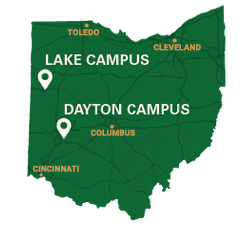Microcredentials

Beginning Fall 2023, students will have the opportunity to earn a microcredential(s) upon successful completion of the defined requirements.
Microcredentials are completed within the curriculum and will appear on the academic transcript as well as through a digital badge. There is no limit to the amount of microcredentials that a student can earn and they are stackable toward certificates and degrees.
Definitions
Microcredential – A competency or skills-based recognition that allows a learner to demonstrate mastery and learning in a particular area. A microcredential is generally a subset of learning achievements or outcomes that is less than a certificate.
Badge – An online credential that recognize skills, achievements, membership affiliation, and participation. The digital credential is issued to students upon successful completion of a microcredential program. Wright State is partnering with Parchment to issue digital badges upon completion of a microcredential.
Frequently Asked Questions
For Students
-
How do I add a microcredential to my academic record?
Undergraduate Students
Instructions on how to declare a microcredential will be posted and communicated to students soon. In the meantime, undergraduate students who wish to add a microcredential to their academic record can contact the Registrar’s Office at wsu-registrar@wright.edu.
Graduate Students
Graduate students must be an admitted graduate student to complete the graduate microcredential programs. All graduate admission requirements will need to be satisfied. Contact the College of Graduate Programs and Honors Studies at wsugrad@wright.edu for more information.
-
Is there a limit to the number of microcredentials I can complete?
There is no limit to the number of microcredentials students can complete. Work with your academic advisor to ensure that microcredential courses are applicable to degree requirements.
-
Can I apply the courses from the microcredential to the degree I am completing?
Yes! As long as the coursework for the microcredential satisfies degree requirements, they can be used. We suggest working with your advisor to confirm that the course(s) can be used toward your degree.
-
Is there a minimum grade I need to earn within the courses that comprise the microcredential?
Undergraduate students must earn at least a C for each course within the microcredential and hold a cumulative GPA of (2.00 GPA) at the undergraduate level.
Graduate students must earn at least a C for each course within the microcredential and hold a cumulative GPA of (3.00 GPA) at the graduate level. If the microcredential is comprised of more than one course, a cumulative 3.0 must be earned within all courses for the microcredential.
-
Why is a microcredential valuable?
Microcredentials allow students to gain knowledge and skills in areas that are important to them. Because microcredentials are small programs, they are easier to add to academic plans than a full major, minor or certificate. This allows learners to diversify their skill set and earn credentials that help meet unique goals.
Microcredentials are aligned with the competencies of the 21st century workforce, including critical thinking, professionalism, intercultural fluency, digital technology and more. These programs are specifically designed to better equip you with the skills that employees demand and to help you to communicate those skills in the right setting.
The digital badges that accompany earned microcredentials are valuable in that they offer more ways to highlight and share skills, knowledge, and achievements, than a transcript.
-
How do students receive their microcredential?
Currently, microcredentials are comprised of one course and will be awarded automatically at the end of the semester upon successful completion. Successful completion is defined within the microcredential’s catalog page.
After the end of the semester and once grades are final, the student’s earned microcredential will display on their academic transcript. Beginning in the Spring 2024 semester, digital badges will also be awarded to students.
Fall 2023 earned microcredentials will be sent their digital badge once it is prepared, likely mid-spring semester.
-
Can I use financial aid to cover the cost?
If you are already enrolled in a degree-seeking program, and the courses within the microcredential are part of your degree or can be counted as free electives to reach the minimum hours for graduation, yes, your financial aid will cover microcredential coursework. Please work with the Office of Financial Aid to confirm your eligibility.
-
What if I completed the course(s) for the microcredential previously, can I still be awarded the microcredential now?
If the course(s) for a microcredential was completed during a term in which the microcredential was an active, they could earn the microcredential. Please contact the Registrar’s Office at wsu-registrar@wright.edu with any individual or specific questions.
For Faculty
-
Why are we offering microcredentials?
Microcredentials:
- allow our institution to offer recognition of learners’ skills and accomplishments in ways that are verifiable and trusted by internal and external consumers alike. (AACRAO, 2022)
- present opportunities to students for value-added learning experiences that have not been traditionally transcripted or credentialed. Experiences have long existed through co-curricular activities, field experiences, service learning and professional development. However, it has been up to learners to include and explain these experiences on their resumes, and they typically have not been easy to verify through the institution. (AACRAO, 2022)
-
Are microcredentials and badges the same thing?
Microcredentials refer to the structured program or experience designed for learners to gain knowledge and competencies in very particular or tailored subjects. Badges or digital badges refer to the artifact issued to students upon successful completion of a microcredential program. A badge is to a microcredential what a diploma is to a degree program.
-
Is there a minimum number of credit hours required for a microcredential?
At this time, microcredentials must have at least one credit hour. Undergraduate microcredentials can be offered for up to 12 credit hours. Graduate microcredentials may be up to 8 credit hours.
It is anticipated that non-credit microcredentials will be offered, but Wright State University does not currently offer them.
-
When will microcredentials begin?
The first microcredentials are expected to be awarded at the end of the fall 2023 semester.
-
When are microcredentials awarded?
Both academic and non-curricular Microcredentials are awarded at the end of each semester, once final grades have been submitted. Similar to diplomas, the digital badge and notation on student transcripts (for academic microcredentials) will likely occur several weeks after each semester ends.
-
Does ODHE, HLC, or CCGS review this request?
At this time, approval past our institution is not required.
-
How do I submit a microcredential proposal in Curriculog?
Similar to program proposals submitted in Curriculog, the microcredential proposal is now available in Curriculog. Both academic and non-curricular microcredentials will be submitted for approval through Curriculog. Non-curricular microcredentials are approved through a shortened workflow; Academic Dean, Provost, Registrar’s Office.
-
Do students need to wait to earn a microcredential(s) at the same time they are graduating from a degree-seeking program?
It is recommended that students earn a microcredential as soon as the requirements have been met. However, they can also be awarded during their final semester at the same time as their degree.
-
Is there an additional cost to earn a microcredential?
There is no additional cost for earning microcredentials, separate from regular course tuition and fees, if applicable.
-
Is there a cost to be admitted to a microcredential program?
If students are already admitted to Wright State University, there is not a separate admission fee for a microcredential. If students are not already admitted, they will need to apply and pay the application fee as non-degree seeking or degree-seeking. Upon admission, students will be able to declare their intent to earn a microcredential.
-
How do students add a microcredential to their academic record?
Microcredentials as part of coursework (Academic microcredentials):
- Currently, microcredential are awarded after completion of one course. As such, it will be awarded automatically at the end of the semester. Students do not need to do anything further.
- During the spring 2024 semester, multi-course microcredentials will likely be offered. The process to earn and be awarded the microcredential will be posted.
-
Is there an automated way for the student to be assigned an advisor/contact when applying for the microcredential?
Upon admission, advisor codes for microcredentials can be assigned. To institute this for microcredentials a program list with faculty members to assign is needed. There can be more than one advisor per program, but there must be some logic that can be programmed.
For example; Dr. Smith is assigned to students with last names A-L and Dr. Conner is assigned M-Z.
-
How will digital badges be awarded?
When the student earns the microcredential it will be noted on their transcript as well as issued via an electronic badge. The badging process will be handled by the Registrar’s Office.
After the Registrar’s Office has cleared applicants for a semester, a report will be run and sent to our partner badging company. That company will then issue the badge electronically. Students earning microcredentials will only receive a digital badge for microcredentials; not a piece of paper similar to a diploma in the mail like they do for a degree.
-
How do microcredential classes get applied to earn credit for another degree if taken at a later time?
Microcredentials can and likely will be awarded separately from the degree the student earns and can count to their degree program; assuming it is in alignment with the program requirements.
If class “X” is taken as part of a microcredential and that same class is part of a degree, then it would automatically count towards the degree—assuming that it meets the requirements of the degree program.
-
What marketing assistance will be provided?
Communication will be built out to students that register for a course(s) that qualifies for a microcredential. Marketing opportunities will likely grow as microcredentials become more established.
-
Are microcredentials stackable?
Credit-bearing microcredential programs may be designed to be stackable and lead to a certificate program or future degree.
-
Why are digital badges issued if the earned microcredential(s) is listed on the student transcript?
Digital credentials are designed to be secure, clickable, and portable. Upon verification of requirements and awarded by an institution, digital credentials are shared with a learner by the institution via email and often through the technology of a third-party vendor. The learner may then further share them with others (such as employers), share them to social media platforms (such as LinkedIn), and/or include links to them in electronic resumes and CVs. When a consumer clicks on the digital credential link, they may be exposed to rich metadata which adds context to the assertion. (AACRAO, 2022)

